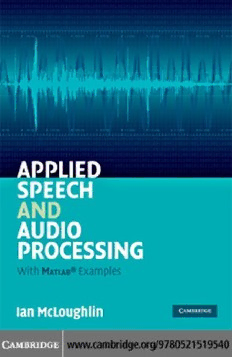Table Of ContentThis page intentionally left blank
Applied Speech and Audio Processing: With MATLAB(cid:1) Examples
Applied Speech and Audio Processing is a Matlab-based, one-stop resource that
blends speech and hearing research in describing the key techniques of speech and
audioprocessing.
This practically orientated text provides Matlab examples throughout to illustrate
theconceptsdiscussedandtogivethereaderhands-onexperiencewithimportanttech-
niques.Chaptersonbasicaudioprocessingandthecharacteristicsofspeechandhearing
lay the foundations of speech signal processing, which are built upon in subsequent
sectionsexplainingaudiohandling,coding,compressionandanalysistechniques.The
finalchapterexploresanumberofadvancedtopicsthatusethesetechniques,including
psychoacousticmodelling,asubjectwhichunderpinsMP3andrelatedaudioformats.
With its hands-on nature and numerous Matlab examples, this book is ideal for
graduatestudentsandpractitionersworkingwithspeechoraudiosystems.
Ian McLoughlin is an Associate Professor in the School of Computer Engineering,
NanyangTechnologicalUniversity,Singapore.Overthepast20yearshehasworkedfor
industry,governmentandacademiaacrossthreecontinents.Hispublicationsandpatents
cover speech processing for intelligibility, compression, detection and interpretation,
hearingmodelsforintelligibilityinEnglishandMandarinChinese,andpsychoacoustic
methodsforaudiosteganography.
Applied Speech and
Audio Processing
With M Examples
ATLAB(cid:1)
IANMCLOUGHLIN
SchoolofComputerEngineering
NanyangTechnologicalUniversity
Singapore
CAMBRIDGE UNIVERSITY PRESS
Cambridge, New York, Melbourne, Madrid, Cape Town, Singapore, São Paulo
Cambridge University Press
The Edinburgh Building, Cambridge CB2 8RU, UK
Published in the United States of America by Cambridge University Press, New York
www.cambridge.org
Information on this title: www.cambridge.org/9780521519540
© Cambridge University Press 2009
This publication is in copyright. Subject to statutory exception and to the
provision of relevant collective licensing agreements, no reproduction of any part
may take place without the written permission of Cambridge University Press.
First published in print format 2009
ISBN-13 978-0-511-51654-2 eBook (EBL)
ISBN-13 978-0-521-51954-0 hardback
Cambridge University Press has no responsibility for the persistence or accuracy
of urls for external or third-party internet websites referred to in this publication,
and does not guarantee that any content on such websites is, or will remain,
accurate or appropriate.
Contents
Preface pagevii
Acknowledgements x
1 Introduction 1
1.1 Digitalaudio 1
1.2 Capturingandconvertingsound 2
1.3 Sampling 3
1.4 Summary 5
2 Basicaudioprocessing 7
2.1 HandlingaudioinMatlab 7
2.2 Normalisation 13
2.3 Audioprocessing 15
2.4 Segmentation 18
2.5 Analysiswindowsizing 24
2.6 Visualisation 25
2.7 Soundgeneration 30
2.8 Summary 34
3 Speech 38
3.1 Speechproduction 38
3.2 Characteristicsofspeech 41
3.3 Speechunderstanding 47
3.4 Summary 54
4 Hearing 59
4.1 Physicalprocesses 59
4.2 Psychoacoustics 60
4.3 Amplitudeandfrequencymodels 72
4.4 Psychoacousticprocessing 74
4.5 Auditorysceneanalysis 76
4.6 Summary 85
v
vi Contents
5 Speechcommunications 89
5.1 Quantisation 90
5.2 Parameterisation 95
5.3 Pitchmodels 117
5.4 Analysis-by-synthesis 122
5.5 Summary 130
6 Audioanalysis 135
6.1 Analysistoolkit 136
6.2 Speechanalysisandclassification 148
6.3 Analysisofothersignals 151
6.4 Higherorderstatistics 155
6.5 Summary 157
7 Advancedtopics 160
7.1 Psychoacousticmodelling 160
7.2 Perceptualweighting 168
7.3 Speakerclassification 169
7.4 Languageclassification 172
7.5 Speechrecognition 174
7.6 Speechsynthesis 180
7.7 Stereoencoding 184
7.8 Formantstrengtheningandsteering 189
7.9 Voiceandpitchchanger 193
7.10 Summary 198
Index 202
Preface
Speechandhearingarecloselylinkedhumanabilities.Itcouldbesaidthathumanspeech
is optimised toward the frequency ranges that we hear best, or perhaps our hearing is
optimisedaroundthefrequenciesusedforspeaking.Howeverwhicheverwaywepresent
the argument, it should be clear to an engineer working with speech transmission and
processing systems that aspects of both speech and hearing must often be considered
togetherinthefieldofvocalcommunications.However,bothhearingandspeechremain
complexsubjectsintheirownright.Hearingparticularlyso.
Inrecentyearsithasbecomepopulartodiscusspsychoacousticsintextbooksonboth
hearingandspeech.Psychoacousticsisatermthatlinksthewordspsychoandacoustics
together,andalthoughitsoundslikeadescriptionofanauditory-challengedserialkiller,
actuallydescribesthewaythemindprocessessound.Inparticular,itisusedtohighlight
the fact that humans do not always perceive sound in the straightforward ways that
knowledgeofthephysicalcharacteristicsofthesoundwouldsuggest.
There was a time when use of this word at a conference would boast of advanced
knowledge,andfamiliaritywithcutting-edgeterminology,especiallywhenitcouldroll
off the tongue naturally. I would imagine speakers, on the night before their keynote
address, standing before the mirror in their hotel rooms practising saying the word
fluently. However these days it is used far too commonly, to describe any aspect of
hearingthatisprocessednonlinearlybythebrain.Itwasagreattemptationtousethe
wordinthetitleofthisbook.
Thehumanspeechprocess,whilemoreclearlyunderstoodthanthehearingprocess,
maintains its own subtleties and difficulties, not least through the profusion of human
languages, voices, inflexions, accents and speaking patterns. Speech is an imperfect
auditory communication system linking the meaning wishing to be expressed in one
brain,tothemeaningbeingimpartedinanotherbrain.Inthespeaker’sbrain,themeaning
isencodedintoacollectionofphonemeswhicharearticulatedthroughmovementsof
severalhundredseparatemusclesspreadfromthediaphragm,throughtothelips.These
produce sounds which travel through free air, may be encoded by something such as
atelephonesystem,transmittedviaasatelliteinspacehalfwayaroundtheworld,and
thenrecreatedinadifferentenvironmenttotravelthroughfreeairagaintotheouterears
ofalistener.Soundscouplethroughtheouterear,middleear,innerearandfinallyenter
thebrain,oneithersideofthehead.Amixtureoflowerandhigherbrainfunctionsthen,
hopefully,recreateameaning.
vii
viii Preface
Itislittlewonder,giventhejourneyofmeaningfromonebraintoanotherviamech-
anismsofspeechandhearing,thatwecallforbothprocessestobeconsideredtogether.
Thus,thisbookspansbothspeechandhearing,primarilyinthecontextoftheengineering
of speech communications systems. However, in recognition of the dynamic research
beingundertakeninthesefields,otherareasarealsodrawnintoourdiscussions:music,
perceptionofnon-speechsignals,auditorysceneanalysis,someunusualhearingeffects
andevenanalysisofbirdsongaredescribed.
Itissincerelyhopedthatthroughthediscussions,andtheexamples,thereaderwill
learn to enjoy the analysis and processing of speech and other sounds, and appreciate
thejoyofdiscoveringthecomplexitiesofthehumanhearingsystem.
Inorientation,thisbookisunashamedlypractical.Itdoesnotlabourlongovercomplex
proofs,norovertediousbackgroundtheory,whichcanreadilybeobtainedelsewhere.
It does, wherever possible, provide practical and working examples using Matlab to
illustrate its points.This aims to encourage a culture of experimentation and practical
enquiryinthereader,andtobuildanenthusiasmforexplorationanddiscovery.Readers
wishing to delve deeper into any of the techniques described will find references to
scientificpapersprovidedinthetext,andabibliographyforfurtherreadingfollowing
eachchapter.
Althoughfewgoodtextbookscurrentlycoverbothspeechandhearing,therearesev-
eral examples which should be mentioned at this point, along with several narrower
texts. Firstly, the excellent books by Brian Moore of Cambridge University, covering
the psychology of hearing, are both interesting and informative to anyone who is in-
terestedinthehumanauditorysystem.SeveraltextsbyEberhardZwickerandKarlD.
Kryterarealsoexcellentreferences,mainlyrelatedtohearing,althoughZwickerdoes
forayoccasionallyintotheworldofspeech.Forasignalprocessingfocus,theextensive
GoldandMorgantext,coveringalmosteveryaspectofspeechandhearing,isagood
reference.
Overview of the book
InthisbookIattempttocoverbothspeechandhearingtoadepthrequiredbyafreshpost-
graduatestudent,oranindustrialdeveloper,embarkingonspeechorhearingresearch.
Abasicbackgroundofdigitalsignalprocessingisassumed:forexampleknowledgeof
theFouriertransformandsomeexposuretodiscretedigitalfiltering.Thisisnotasignal
processingtext–itisabookthatunveilsaspectsofthearcaneworldofspeechandaudio
processing, and does so with Matlab examples where possible. In the process, some
of the more useful techniques in the toolkit of the audio and speech engineer will be
presented.
The motivation for writing this book derives from the generations of students that
I have trained in these fields, almost each of whom required me to cover these same
steps in much the same order, year after year. Typical undergraduate courses in elec-
tronic and/or computer engineering, although they adequately provide the necessary
foundationalskills,generallyfailtopreparegraduatesforworkinthespeechandaudio

